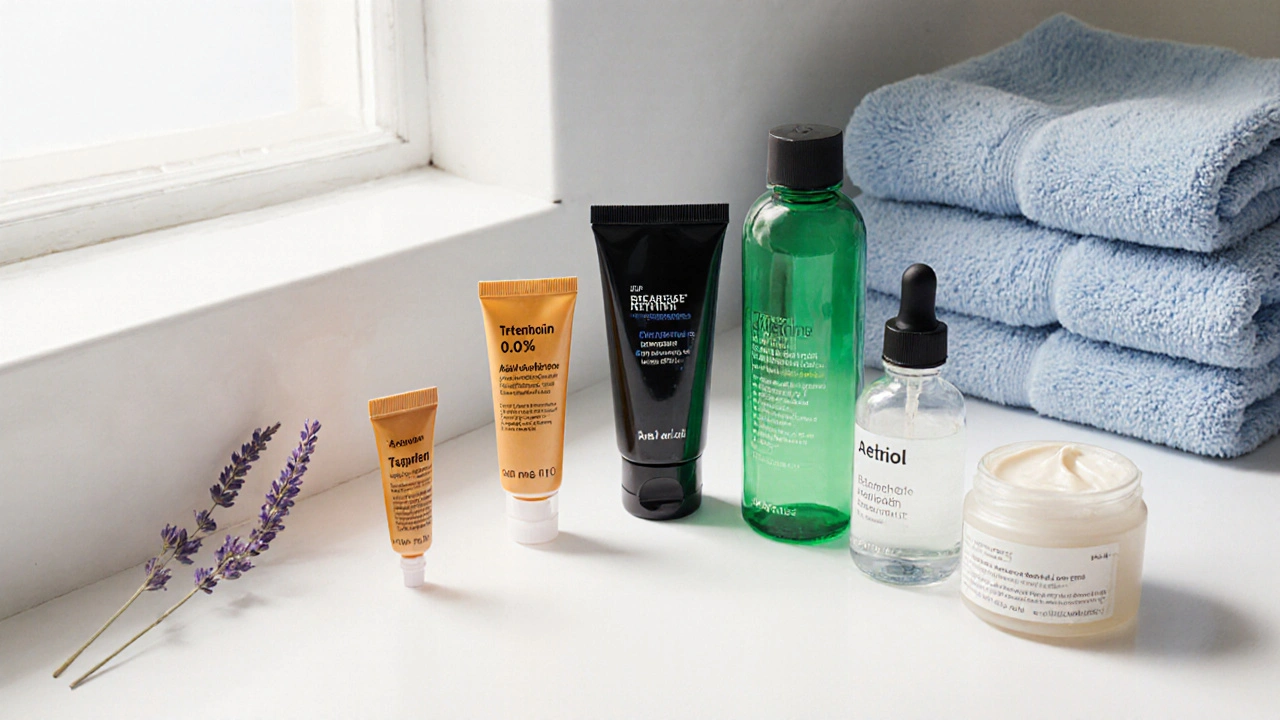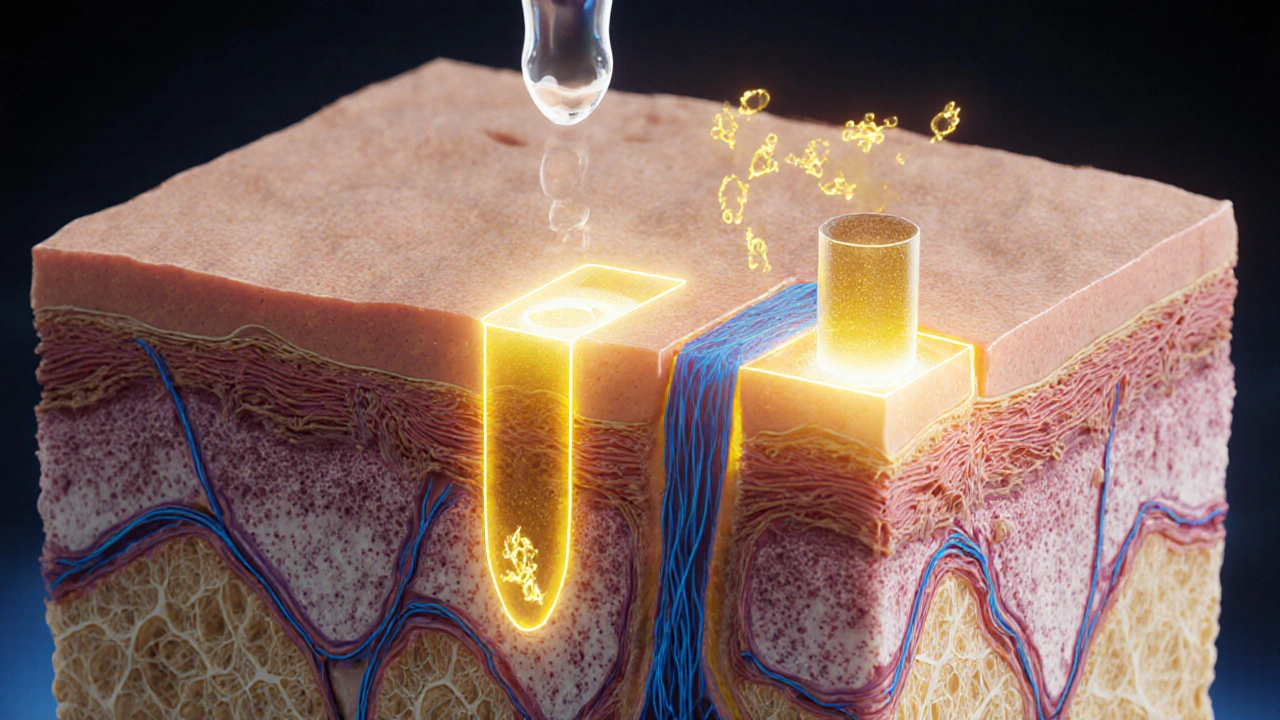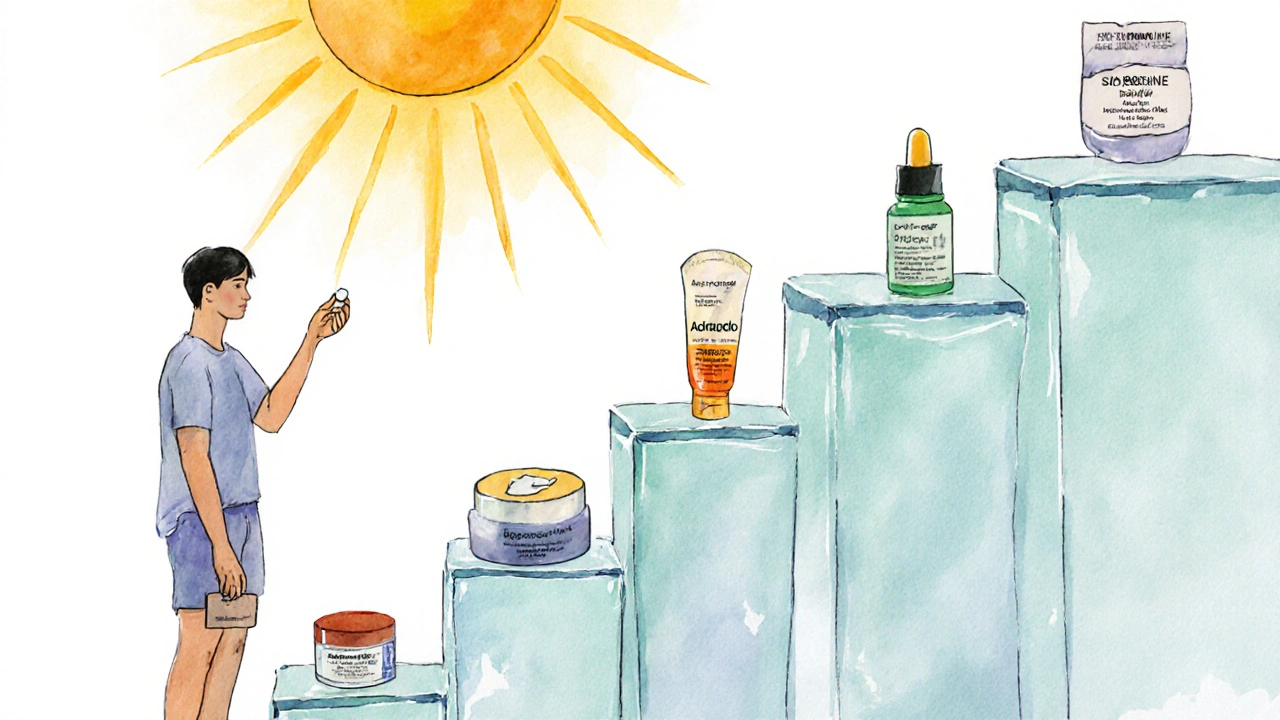Tretinoin 0.05% vs Other Retinoids: A Practical Comparison

Retinoid Comparison Guide
Tretinoin 0.05%
Prescription strength for acne and aging
Retinol
Gentle OTC alternative for beginners
Adapalene
Mild irritation, acne-focused
Tazarotene
High potency, high irritation
Azelaic Acid
Anti-inflammatory, reduces hyperpigmentation
Compare Key Factors
Recommended Retinoid:
Why This Matters
Choosing the right retinoid depends on your skin type, concerns, and tolerance. Tretinoin 0.05% is often recommended for those seeking fast results, but it comes with higher irritation potential. Retinol is gentler but works slower. Adapalene offers a middle ground, while tazarotene is the most potent but also the most irritating.
Quick Takeaways
- Tretinoin 0.05% is a prescription‑strength retinoid prized for fast results on acne and fine lines.
- Adapalene (0.1‑0.3%) and tazarotene (0.05‑0.1%) are the next‑most potent options, each with a distinct irritation profile.
- Retinol is the gentlest OTC alternative, suitable for beginners or sensitive skin.
- Azelaic acid isn’t a retinoid but often paired with them to calm redness and reduce hyperpigmentation.
- Choosing the right product hinges on prescription access, skin tolerance, and your primary concern-acne, aging, or both.
What isTretinoin a high‑potency retinoic acid used to treat acne and signs of photo‑aging0.05%?
When you see "0.05%" on a tretinoin tube, it means the cream contains 0.05grams of the active ingredient per 100grams of product-roughly one part in two thousand. This concentration sits at the low‑end of prescription‑strength retinoids, making it a popular starting point for people who need more than an OTC retinol but aren’t ready for the strongest formulas.
The molecule works by binding to retinoic acid receptors (RAR) in skin cells, accelerating turnover, unclogging pores, and stimulating collagen production. Clinical studies from the early 2000s show a 30‑45% reduction in inflammatory lesions after 12weeks of nightly use, and a measurable improvement in skin texture after 6months.
Because it’s a prescription drug in the U.S., Canada, and most of Europe, you’ll need a dermatologist’s approval. The trade‑off is tighter regulation of purity and dosage, which translates into more reliable results compared with many over‑the‑counter options.

Key Alternatives to Tretinoin 0.05%
When you ask, "What can I use instead of tretinoin?", three options dominate the conversation:
- Adapalene a synthetic retinoid originally marketed for acne (typically 0.1% or 0.3%).
- Tazarotene a third‑generation retinoid approved for acne and psoriasis (0.05% or 0.1%).
- Retinol a vitaminA precursor that converts to retinaldehyde in the skin, available OTC in concentrations from 0.1% to 1%.
Many dermatologists also sprinkle Azelaic Acid a dicarboxylic acid that reduces inflammation and hyperpigmentation into treatment plans, especially when patients experience excess irritation from retinoids. While not a retinoid, azelaic acid is worth mentioning because it often works hand‑in‑hand with the above options.
Head‑to‑Head Comparison
| Attribute | Tretinoin0.05% | Adapalene | Tazarotene | Retinol |
|---|---|---|---|---|
| Prescription status | Prescription‑only (U.S.) | Prescription (0.1%/0.3%); OTC in some EU countries | Prescription‑only | Over‑the‑counter |
| Typical use | Acne, fine lines, hyperpigmentation | Acne (particularly comedonal) | Acne, psoriasis, photo‑aging | Anti‑aging, mild acne |
| Onset of visible improvement | 4-6weeks (acne), 3-4months (wrinkles) | 6-8weeks | 2-4weeks (acne), 3months (wrinkles) | 12weeks‑plus (depends on concentration) |
| Irritation risk (dryness, peeling) | Moderate‑high | Low‑moderate | High | Low |
| Cost (average 30‑day supply, U.S.) | $30‑$70 (generic) | $40‑$90 | $70‑$120 | $20‑$50 |
The table makes the obvious trade‑offs clear: tretinoin sits in the sweet spot of potency and price, but you’ll need a prescription. Adapalene offers a gentler entry with a similar prescription barrier, while tazarotene pushes potency to the max and carries the steepest irritation price tag. Retinol is the most affordable and easiest to obtain, but it works slower and may not clear stubborn acne.
How to Choose the Right Retinoid for Your Skin
Think of retinoids as a ladder. If you’re just starting out or have very sensitive skin, begin at the bottom with retinol. If you’ve already tolerated retinol and want faster results, step up to adapalene. When acne is severe, or you’re targeting both acne and deep wrinkles, tretinoin or tazarotene become viable options-provided you can handle the possible redness and peeling.
Here’s a quick decision guide:
- Primary concern = mild acne + beginner tolerance: Retinol 0.3%-0.5% nightly.
- Primary concern = moderate acne, low irritation tolerance: Adapalene 0.1% (prescription) or 0.3% (OTC in EU).
- Primary concern = stubborn acne + early signs of aging: Tretinoin 0.05% (prescription).
- Primary concern = severe acne, psoriasis, or deep wrinkles: Tazarotene 0.05% (prescription).
- Extra redness or post‑inflammatory hyperpigmentation: Pair any retinoid with azelaic acid 10%-15%.
Always run a patch test first and consider consulting a Dermatologist a medical doctor specializing in skin health before jumping to the strongest options.

Best Practices for Safe Use
- Start slow. Apply a pea‑size amount every third night for the first two weeks.
- Moisturize. Use a non‑comedogenic barrier cream (e.g., ceramide‑rich) 15minutes after the retinoid.
- Sun protection. Retinoids thin the stratum corneum; a broad‑spectrum SPF30+ is mandatory daily.
- Avoid irritating combos. Skip benzoyl peroxide, salicylic acid, or alcohol‑based toners for the first month.
- Watch for signs of over‑use. Excess redness, swelling, or crusting >48hours may mean you need to back off to every‑other‑night.
When an irritation flare occurs, the "sandwich method" works well: moisturize, apply retinoid, then moisturize again. This buffers the active ingredient and reduces peeling without sacrificing efficacy.
Potential Pitfalls and How to Dodge Them
Even the best‑designed regimen can stumble if you ignore a few common traps:
- Expecting overnight miracles. Retinoids remodel skin at the cellular level; patience is key.
- Using the wrong concentration. Beginners who jump to 0.1% tretinoin often quit early due to severe irritation.
- Skipping sunscreen. UV exposure can undo weeks of collagen boost and increase hyperpigmentation.
- Mixing with harsh exfoliants. Physical scrubs or high‑strength AHA/BHA acids amplify irritation.
- Not adjusting for pregnancy. All prescription retinoids are contraindicated during pregnancy; switch to azelaic acid or a non‑retinoid regimen.
If you hit a snag, pause the retinoid for 3-5days, focus on barrier repair, then resume at a reduced frequency.
Frequently Asked Questions
Can I buy tretinoin 0.05% without a prescription?
In the United States, Canada, and most of Europe, tretinoin is classified as a prescription‑only medication. Some countries allow low‑strength versions (e.g., 0.025%) OTC, but 0.05% typically requires a doctor’s approval.
How does tretinoin differ from retinol?
Tretinoin is the active form of vitaminA (all‑trans retinoic acid). Retinol is a precursor that must be converted by skin enzymes into retinoic acid, a process that can lose up to 90% efficiency. Consequently, tretinoin works faster and stronger but also irritates more.
Is adapalene suitable for anti‑aging?
Yes, adapalene stimulates collagen synthesis and improves skin texture, though its primary FDA‑approved indication is acne. For dedicated anti‑aging, many clinicians still prefer tretinoin or tazarotene because they have more robust data on wrinkle reduction.
Can I combine azelaic acid with a retinoid?
Absolutely. Azelaic acid (10%-15%) can calm inflammation and fade post‑inflammatory hyperpigmentation while the retinoid tackles the root cause of acne and aging. Apply azelaic acid in the morning and the retinoid at night for best tolerance.
What’s the safest way to stop using tretinoin?
Gradually taper the frequency over 2-4weeks (e.g., nightly → every other night → twice a week) while keeping a robust moisturizer and sunscreen routine. Sudden cessation can cause a brief rebound of oil production.
If you followed the steps above, you now have a clear picture of how compare tretinoin 0.05 to its main rivals, which product aligns with your skin goals, and how to use it without drama. Remember, the best retinoid is the one you can stick with consistently.

Anirban Banerjee
October 9, 2025 AT 17:51Colleagues, let us consider the hierarchical nature of retinoid potency when advising patients; the therapeutic gradient from retinol to tretinoin requires a measured approach that aligns with both clinical efficacy and individual tolerance.
Mansi Mehra
October 12, 2025 AT 01:25The table accurately reflects the relative costs of these products.
Jagdish Kumar
October 14, 2025 AT 08:58Behold the saga of retinoids, where each molecule dons a crown of promise and peril, and the humble retinol steps onto the stage as the timid understudy before the flamboyant debut of tretinomycin, a.k.a. tretinoin, which commands the spotlight with relentless vigor.
Aminat OT
October 16, 2025 AT 16:31I feel the ache of every breakout you’ve fought, the midnight tears of your skin barrier, and I’m here to remind you that azelaic acid will hug those inflamed pores like a warm blanket on a cold night.
Amanda Turnbo
October 19, 2025 AT 00:05While the guide is thorough, it overlooks the socioeconomic barriers that many patients face, especially when prescription‑only tretinoin can cost more than a month’s rent for some families.
Jenn Zuccolo
October 21, 2025 AT 07:38From a philosophical perspective, the choice of retinoid mirrors the eternal human quest for balance between ambition and restraint; one must weigh the allure of rapid transformation against the humility of gradual adaptation.
Courtney The Explorer
October 23, 2025 AT 15:11America leads in dermatological research!; however, the US market also inflates prices-unfairly-making it harder for everyday users to access the best formulations.
Ashleigh Connell
October 25, 2025 AT 22:45I appreciate the balanced tone of the article and would add that pairing any retinoid with a gentle, ceramide‑rich moisturizer can dramatically reduce the irritation while preserving efficacy.
Erin Knight
October 28, 2025 AT 06:18The author’s omission of longitudinal safety data is a glaring oversight; without evidence spanning beyond six months, clinicians cannot fully counsel patients on the risk of sustained hyperkeratosis or potential systemic absorption.
Kavita Jadhav
October 30, 2025 AT 13:51I understand the hesitation many feel when stepping up potency, and I want to reassure you that a gradual titration schedule-starting with every third night-can foster resilience in the skin barrier.
Tony Halstead
November 1, 2025 AT 21:25Friends, let us embark on a comprehensive reflection regarding the nuanced selection of retinoids, for the journey is seldom linear and demands an interdisciplinary mindset.
First, acknowledge that skin type dictates baseline tolerance; oily, resilient dermis may endure higher concentrations without compromising integrity.
Second, the temporal dimension of results must be calibrated: while tretinoin may reveal visible improvement within four weeks for acne, its anti‑aging benefits manifest over several months, necessitating patient patience.
Third, consider the psychosocial context-cost, access to dermatology, and cultural attitudes toward prescription medication all shape adherence.
Fourth, the synergistic potential of adjuncts such as azelaic acid should not be dismissed; it can quell inflammation while the retinoid performs its remodeling duties.
Fifth, a structured tapering protocol when discontinuing is essential to avoid rebound sebum production, which can manifest as a sudden flare.
Sixth, sunscreen is non‑negotiable; neglecting broad‑spectrum protection nullifies the collagen‑stimulating effects and accelerates photo‑damage.
Seventh, the molecular mechanism-direct retinoic acid receptor agonism versus pro‑drug conversion-underpins speed of action, explaining why tretinoin outpaces retinol.
Eighth, monitor for signs of over‑use: persistent erythema, crusting, or desquamation beyond 48 hours signals a need to reduce frequency.
Ninth, patient education on the “sandwich method” can enhance comfort, allowing a moisturizer barrier both before and after application.
Tenth, remember that dermatologic research continually evolves; emerging data on lower‑dose formulations may soon shift current paradigms.
In sum, the optimal retinoid regimen is a personalized tapestry woven from clinical evidence, individual physiology, and lived experience.
leo dwi putra
November 4, 2025 AT 04:58Oh, the melodrama of choosing a retinoid! The drama escalates when someone claims that a single drop can cure all skin woes, ignoring the quiet, steadfast effort required nightly.
Krista Evans
November 6, 2025 AT 12:31You’ve got this, just start slow and let your skin adapt; celebrate each tiny improvement and keep that sunscreen on!
Mike Gilmer2
November 8, 2025 AT 20:05Let us dramatize the ascent from retinol’s gentle whisper to tretinoin’s thunderous roar, for every skin journey deserves an epic narrative.